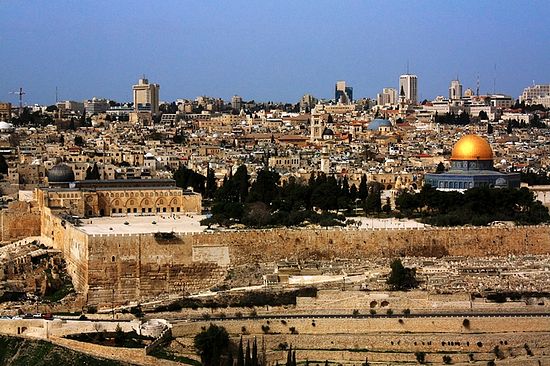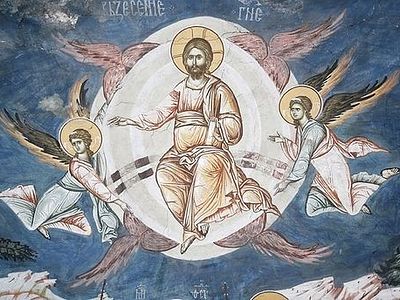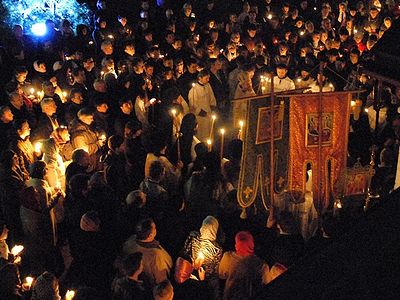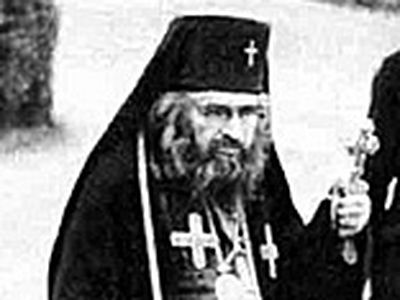Jerusalem—in translation, “house of peace”—is set upon high hills. It is surrounded on the east, south, and west by the deep valleys of Kidron, Hinnom, and Gihon. Another valley, the Tyropoeon, cuts across the city lengthwise and separates the broad western hill with the Upper City upon it from the eastern hill, where the Jerusalem Temple stood. Its territory is a man-made plateau, surrounded on all sides by walls built from parallel rows of enormous stone boulders. Along the edges of the plateau are courts and porticos, encircling the “inner temple” with its special barrier before the women’s court, beyond which is a wall separating the sanctuary. Beyond the western wall rises Herod’s palace, surrounded by separate fortifications. To the northeast, beyond a large, square tower with mighty gates, rises Golgotha. To the north, bordering the city wall itself, is the Anthony fortress with the Roman garrison,[1] and beyond it, the Garden of Gethsemane.
In the olive grove on the northwest slope of Golgotha an empty tomb is seen…
In the early morning light, wrapping tightly in their veils, the astounded women run quietly along the path between the stones. Overcome with trembling and awe, amazed by the vision of the heavenly Angel, the empty tomb and the Angel’s glad tidings, they are hastening to depart from that place. Some of them, as the apostle Mark says, neither said … any thing to any man; for they were afraid (Mark 16:8). “While others followed after the Mother of God and were made glad by the vision and words of the Lord.”[2] Before them in radiant garments of Divine glory stood the risen Jesus. “Rejoice!” He said. And they came and held him by the feet, and worshipped him (Mt. 28:9).
How did they hold Him by the feet if He had said to Mary Magdalene Touch Me not (Jn. 20:17)? We find an answer from St. Gregory Palamas. He writes that “All the women came [to the sepulcher] after the earthquake and the fleeing of the guards, and found the tomb open and the stone rolled away; but when the Virgin Mother came, then there was [that very] earthquake, … the stone rolled away, ... the tomb opened, and the guards were present, although … they were so shaken with fear that after the earthquake they had come to their senses and quickly took to flight. But the Mother of God felt no fear and rejoiced when she saw what had happened.”[3] Then, after some time had passed, when the Risen One Himself “appeared to His Mother and the women there with her, He permitted her alone to hold His feet, although St. Matthew makes the other women also partakers of this, not wishing … to plainly prefer the Mother as witness to these things.[4]
Christ is Risen! Thus speaks the holy Gospels, thus do His early witnesses proclaim; and throughout the twenty centuries’ history so do thousands upon thousands of people directly proclaim the risen Christ. From century to century, living witnesses experience and personally see that Christ is risen! There have always been people who can say: “I met Him face to face.”[5] I know for certain that Jesus of Nazareth, Who was crucified on Golgotha, Who died, Who was buried, truly rose again and lives…
But having barely restored the broken discipline among the soldiers who had nearly lost their minds from ice-cold terror, the centurion got to thinking about the future: We ran away, abandoned our post. If no one intercedes for us, shame and punishment awaits the entire detachment. Who will believe what we saw? The higher command—the prefect of the auxiliary Sebastian cohorts[6] and tribunals—are resting, as they belong to the cavalry division. A few centurions who are maintaining order by the outer temple galleries are under the command of the first centurion of the first maniple—the senior officer of the Sebastian cohorts. We both once served as simple legionnaires in the Praetorian Guard and know quite well that our former commander, Aelius Seianus, is the right hand man of Emperor Tiberius and prefect of the Praetorian Guard—the Jews’ sworn enemy.[7] The Prefect Pilate[8] also dislikes him, however, this will not excuse us. But although the governor will not be severe for the sake his hated Jews, we did abandon our post, and will be subject to punishment. It’s decided! We have to report everything to the chief centurion of the first maniple. Maybe for the sake of friendship he will give us some useful advice—after all, we are both Roman born…
In the Jerusalem Temple, with the first rays of the rising sun, the ritual sacrifice of the Law had already been offered, the incense was burning, and the Levites chanted the 23rd Psalm, appointed for the first day of the week. The divine services were conducted barefoot. The row of priests stood importantly in their white linen garments with long sleeves. They served in raiment belted by colored cinctures in several knots, and with headbands tied around by “cylinders”, or open-top caps. Most impressive is the high priest in his ephod, or split shoulder strap fixed on either shoulder by gold fasteners with onyx, and gathered by a belt made of gold and colored threads. The hem of his linen garment is adorned with pomegranates and gold bells. Precious stones glisten on his ephod—the symbols of the twelve tribes of Israel, and on Caiaphas’ turban a blue cord fixes the traditional gold disk over the forehead, with the words “Holy things to the Lord” inscribed.
Receiving the sacrificial portion of the animal from the priests’ hands, pouring the fragrant oil from the sacrificial chalice[9] over the base of the altar and bringing the “first” bushel of barley to the Lord, the high priest Caiaphas then removes his vestments—his splendid garments and magnificent adornments. The Sanhedrin servant approaches him respectfully and speaks several phrases to him in a low voice. Joseph Caiaphas’s brow becomes furrowed.
“Why does the Roman officer and his soldiers wish to meet with me during these days of the Passover? The company of pagans will defile me! Seven days prior to the onset of the Old Testament Passover, the tribune of cohorts under the command of the maniples comprising the garrison in the Anthony fortress[10] has already given my high priestly garments to the treasurers. They are supposed to return them one day after the festal period,[11] but the solemnities are not over yet—it is too early. Why did they come? What do they need?”
We can read the answer to this question in the Gospels. Now when they were going, behold, some of the watch came into the city, and shewed unto the chief priests all the things that were done. And when they were assembled with the elders, and had taken counsel, they gave large money unto the soldiers, saying, Say ye, His disciples came by night, and stole him away while we slept. And if this come to the governor's ears, we will persuade him, and secure you. So they took the money, and did as they were taught: and this saying is commonly reported among the Jews until this day (Mt. 28:11-15).[12]
That day, on April 9, 30 AD, when the veterans of the Sebastian cohort emerged from temple gallery they felt much better. Weighty purses with silver hung from their belts, and the future did not appear so dark as they had imagined—all they had to do was to spread false rumors around the city.[13] If their superiors learn of what took place, then the high priest Caiaphas and his influential father-in-law Annas[14] will intercede on their behalf before the governor and save them from punishment…[15]
At that same time, the joyful and amazed myrrh-bearers hastily tell the apostles about their encounter with the Risen One; however, the Lord’s disciples have not yet seen anything for themselves other than the open entrance to the tomb, the burial shroud, and napkin cast aside. The burial site was empty; but where was their beloved Teacher? The disciples are tormented by doubt: Was it really Him whom the women had seen? And their words seemed to them as idle tales, and they believed them not (Lk. 24:11). Then the apostle Peter rose, girded himself, again threw his cloak around him and ran a second time to look—would something else be revealed to him? But once more, He beheld the linen clothes laid by themselves, and departed, wondering in himself at that which was come to pass (Lk. 24:12). The Lord’s disciples were confused. They had dreamt of some appearance of blinding, divine power and glory that would run the “Roman boot” out of Jerusalem and put to shame the legion[16] that had trampled their native land under foot. They had trusted that it had been he which should have redeemed Israel (Lk. 24:21), establishing a powerful earthly kingdom of the Anointed One.[17] But the Roman citadel, the tower of Anthony still loomed over the holy city, and the enemy forces were still overrunning their fatherland. Their thoughts still remained yet far from comprehending what had actually happened. They had not yet been vouchsafed to see the divinely radiant and glorious Resurrection.
Therefore, in the evening of the first day of the week, when the two disciples Luke and Cleopas[18] were walking from Jerusalem to Emmaus, they had gone 60 furlongs[19] of the way in deep sorrow. The road to Emmaus ran along hills and valleys that became more and more like a desert the farther one walked from Jerusalem. But Emmaus was located over a river bed with a small stream running through it; the grape vines and olive trees on the terraced hillside, the white and red blossoms of the almond tree, made the end of the journey pleasant.[20] And when Luke and Cleopas were walking in their dust-covered cloaks, a fellow Traveller caught up with them.[21] He asked the disciples why they were so sad, at which Luke and Cleopas reproached Him: how is it that You are the only one in Jerusalem who does not know about the events that have just taken place? (Lk. 24:19-24).
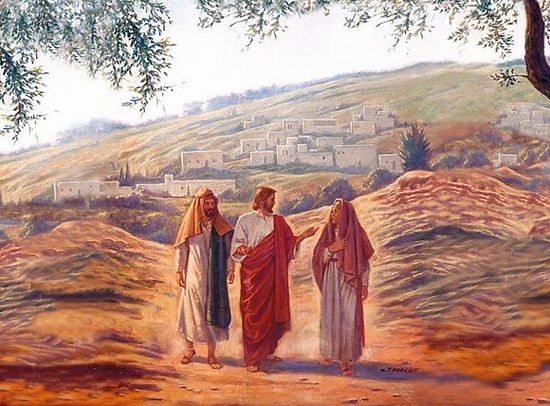
Saying these words, Luke and Cleopas truly “did not see” with Whom they were speaking! They did not see the Risen One! Why? After all, He stood before them, and their hearts burned (Lk. 24:32)! Because everything they said corresponds perfectly with what was written later by Josephus Flavius and Cornelius Tacitus—the words of objective observers.[22] They call Him Jesus the Nazarene, one of the executed prophets—which not contradict the Judaic tradition.[23] This corresponds to the words of people who had watched the Resurrection from the outside, who did not personally participate in it. Before the crucifixion the disciples hoped that He would be the Deliverer and Savior, but now they did not feel this and therefore did not recognize Him.[24]
In reply, the Risen One revealed to them, and through them also to us, the essence of the Old Testament books. He explained that according to those very Scriptures, the Messiah was to be crucified, to die, and then to resurrect. And when the travellers neared Emmaus, Jesus, not accepted by His disciples, made as if to go on further, but a mysterious power bound them to Him. The wonderful evening, the pink sky, purple hills, the town surrounded by limestone cliffs in the haze… Luke and Cleopas constrained Him, saying, Abide with us: for it is toward evening, and the day is far spent (Lk. 24:29). Jesus agreed, and although He was a guest in a stranger’s house, when He sat down to eat He acted as the head of the family. Following the custom, He took the bread, blessed it, broke it and gave it to them as He had done before at table with them. At that moment, it was as if a veil fell from their eyes and Luke and Cleopas recognized Jesus. They recognized Jesus as the Christ, the Messiah, the bread of life! They recognized in Him the Savior and Redeemer. Then, His Resurrection appeared within them and they truly “saw” Him. Jesus became invisible to ordinary eyes, but visible to the inner eye; He became their light and their strength.
From that time on they saw the Resurrection, and told each other about their inner stirring of feelings. Did not our heart burn within us, while he talked with us by the way, and while he opened to us the scriptures? (Lk. 24:32). Disregarding the late hour, they immediately turned back to Jerusalem, burning with impatience to tell everything that they had seen and still see within. Do not sorrow, as did Luke and Cleopas on their way to Emmaus. Rejoice, as did Luke and Cleopas, hastening back to the Holy City with glad tidings. There is no cause to remain in grief—Christ is Risen! After all, it was not just a historical event, but a manifestation of universal scope. It was not merely Romans routed from Jerusalem, but the victory over all-powerful sin and the captivity of death. It was not the restoration of the mighty kingdom of Israel, but the establishment on earth of the Kingdom of Heaven, and the gates thrown open to eternal habitations!
Nevertheless, according to the testimony of the Gospel of Mark (Mk. 16:13), when Luke and Cleopas returned to Jerusalem, the disciples did not believe their story… What a powerful obstacle there is in people’s hearts, preventing them from believing in the resurrection of the Savior! But the Conqueror of death and hell again appears to the disciples, illumines them with the rays of Divine truth, and brings to completion their initiation into the mystery of His victory-bearing glory. One evening, when the apostles were abiding in the upper room behind closed doors, the risen Christ appears before them and grants them His peace.
One of the many single-story stone houses in Jerusalem, with a flat roof, and rooms arranged in a closed quadrant around the inner court and garden that provides cool and shade in the summer heat. A sturdy wooden door leading to the street, shut tight with bars and a large wooden beam on the inside. The tiny windows that look into the inner court give almost no light, and inside one of the rooms with a low ceiling an oil lamp burns perpetually. There are a few mats on the floor, a bench, and a stove for warmth during the winter months. On three sides of the largest mat that serves as a table, the Lord’s disciples recline on their left elbows, dressed in red, gray, yellow, and striped tunics that fall to their ankles. Their outer garments are laid aside, and by the door are a row of sandals. They have gathered together, fortified the doors out of fear before the Jewish authorities, who have ordered a search for the disciples of the One Crucified during these days of the Passover.
Suddenly, in the triumphal garments of divine glory, the Risen Christ stands amongst them and shows them His hands and side. “He appeared to them in meek visage, and His voice soothed their troubled thoughts…, saying, Peace be unto you, that is, ‘do not be troubled.’ By this He reminds them… of the words He had said before His sufferings: My peace do I give unto you (Jn. 14:27).”[25] And then came the peace that passes all understanding.
The disciples rejoiced, seeing the Lord (Jn. 20:20).
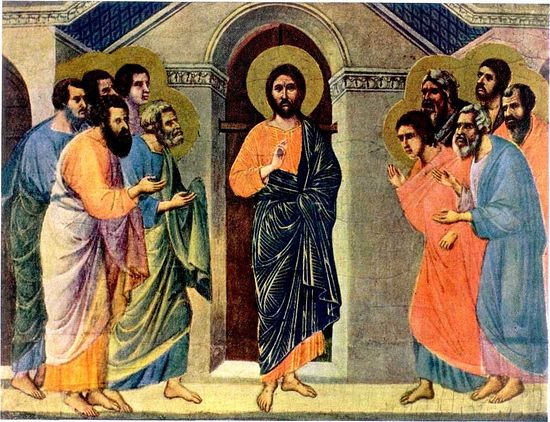
The apostles found grace when they beheld the risen Messiah. They understood that it was He, risen from the dead, who stood now before their eyes, and they were beholding Him personally, face to face. And ye now therefore have sorrow: but I will see you again, and your heart shall rejoice, and your joy no man taketh from you (Jn. 16:22).[26]
And so the disciples “were amazed at the unexpectedness and improbability”[27] of what they saw, radiant and shining. He said to them, Have ye here any meat? And they gave him a piece of a broiled fish, and of an honeycomb. And he took it, and did eat before them. (Lk. 24:41-43).
He eats in front of them… After His Resurrection, the Savior’s body was incorruptible, and therefore had no need of food. The Risen One took food not according to the nature of mortals, not by the process of digestion. The food was burned by divine energy, as the flame of a candle burns wax, and not processed in the natural human way. “He did this in order to prove His Resurrection to them …”[28] Now the disciples see that Christ Himself is standing before them with a transfigured and spiritual body.
Then said Jesus to them again, Peace be unto you: as my Father hath sent me, even so send I you. And when he had said this, he breathed on them, and saith unto them, Receive ye the Holy Ghost: Whose soever sins ye remit, they are remitted unto them; and whose soever sins ye retain, they are retained (Jn. 20:21-23).
But during the apostle Thomas was not present this appearance in the upper room, and when the apostles told him, We have seen the Lord, he asks for proof. Why?
The disciples having seen the Lord (Jn. 20:20) and receiving the grace of the Holy Spirit, said to Thomas that they had seen and recognized Him, and understood rightly that before them was the Risen One Himself. Thomas wanted the same thing. Except I shall see in his hands the print of the nails, and put my finger into the print of the nails, and thrust my hand into his side, I will not believe (Jn. 20:25).
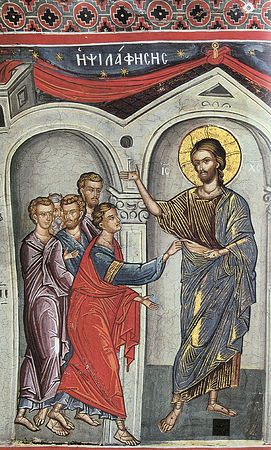
So many people have not stood face to face with the risen Christ and yet believe in Him! The goal of man’s spiritual life is union with the risen Savior, to contemplate Him in the depth of the heart, and faith here plays a decisive role. When Christ rises within the rational soul of a believing person, He overcomes its sinful suggestions, just as He once overcame the sealed stone tomb. The one who dedicates himself to the unfathomable power of the Resurrection attains theosis, deification, and thus fulfills the goal of his existence. We especially need this rebirth: Therefore we are buried with him by baptism into death: that like as Christ was raised up from the dead by the glory of the Father, even so we also should walk in newness of life (Rom. 6:4). It follows that Pascha is the coming of Christ in the depth of the heart, it is the coming of God the Word to human reason. And if the feast of Christ’s Resurrection is a yearly Pascha, then there is also a weekly Pascha—each Sunday. For when we come together for Divine Liturgy, at the Eucharist we partake of the Body and Blood of Christ; that is, we ourselves take part in the Pascha of the Lord.[30] Blessed is he in whom faith precedes seeing and accepting! Therefore, blessed are they who have not seen, and yet have believed (Jn. 20:29)
People of Semitic origin—Jews and Arabs—are least of all dreamers. The springtime in Galilee, the blinding sky, the beauty of nature do not arouse any subtle exaltation in them. Such people are strangers to daydreams; they really do see the Risen One on the sea of Tiberius! Children, He said, do ye have any meat? Their eyes opened, and the beloved disciple said to the apostle Peter, It is the Lord! (Jn. 21:5-9). They are not imagining it—they are really talking with Him, they really eat the bread and fish, mysteriously prepared by the Redeemer! Then, there in Galilee, the risen Savior again appears to the apostles and five hundred of the faithful[31]—this is written at the very end of the Gospel according to Matthew (Mt. 28:16-20). At this appearance, Jesus Christ commands the apostles to go forth and preach the Gospel throughout the universe and gives a promise to the faithful: Lo, I am with you always, even unto the end of the world (Mt. 28:20). In the epistle to the Corinthians, the apostle recalls yet another appearance of the risen Lord—the appearance to the apostle James; however, there is nothing written about it in detail (1 Cor. 15:7). And finally, before His Ascension, the Savior appeared to His apostles and gave them separate instructions and blessings (Lk. 24:45-51).[32]
Just as there is no greater humiliation than the humiliation the Son of God took upon Himself, dying the death of a criminal on the Cross, neither is there any glory higher than that by which the Son of man was crowned for accepting this death. And after the end of the forty days, our human nature, the nature that suffered, was buried, and resurrected in Christ, ascended to heaven—the glorified nature, which has taken on divine lordship and power. If the source of our nature is holy, then all the members of the Church are also consecrated: where the head is, there also must the members be. Our Lord Jesus Christ ascended to heaven and paved a way for us—there is no longer an impassible gulf fixed between heaven and earth. We live a short time in this life; the Savior ascended to heaven and prepared a place for us in blessed eternity.
There are countless multitudes of people who believe in the Resurrection, but there are those, albeit a few, who every hour see the risen Christ resplendent and radiant in lightning rays of incorruption and divinity. The former are witnesses of Christ’s Resurrection “by hearsay”, while the latter, “by seeing”, because the Orthodox Church, as the Resurrected Body of the Savior, gives us all the means by which we can personally enter into the reality of the Resurrection. In singing “Having beheld the Resurrection of Christ…” we turn not only to the historical facts of the Lord’s appearance to the disciples after the Resurrection, but also directly to the risen Christ Himself, contemplated by us in the depths of the Holy catholic (universal) and apostolic Church.[33]
During the course of forty days, when the Paschal services are celebrated, our attention turns to the events that took place after the Resurrection of Christ. When we read the Gospels, when we hear how everything happened, when we pay attention to the services, our hearts are filled with joy. We become living participants of these events: we spend time in garden of Joseph of Arimathea, by the tomb; with the Myrrh-bearers we see the angel, we have personal contact with the risen Christ the Savior.
“A question stands before us: which kind are we? Do we talk about Christ’s Resurrection only in other people’s words? Do we really rejoice with a full heart? … Are we convinced only because other people know this and we trust them, or has this news done something to us—and knowing by experience that Christ has risen, we can no longer be the same as we were before?
“We can know this by experience in various ways.
“We can know this in prayer, by touching the hem of Christ’s garment; we can know Him in certain moments, when we suddenly feel that He is standing invisibly but truly alive before us. Although I do not see Him or hear Him, do not perceive it with my senses, He is here. We can perceive this also in an unfathomable way in Communion of the Holy Mysteries. Confession, Chrismation, the anointing with holy oil, and various Church rites can change a person from within; and if only he thinks about it, he cannot but believe that this is all happening through divine power, which is given through the crucified and risen Christ.”[34]
The Bright Matins begin… The Royal Doors and curtains are closed, and we hear from the altar the hymn, “Thy Resurrection, O Christ our Savior…” Why is this hymn sung? Because the first to know that Christ had risen were the angels—heaven knew before the earth did. Symbolizing this, the curtains are pulled open, but the Royal Doors are still closed. Then they also open, and the solemn procession with lit candles begins. This Cross procession indicates the walking of the apostles and myrrh-bearers on the Paschal night, on that early morning of the Resurrection, from Jerusalem to the tomb of Christ the Savior.
Now the Cross procession stops at the western doors of the Church. The doors are closed, but the priest makes the sign of the cross over them thrice with his three-candled cross. The service begins outside the church in the midnight darkness, with the singing of “Christ is risen from the dead…” This signifies the renewal of the world from the darkness of sin, cleansed by grace, and the stone rolled away is symbolized by the opening of the doors of the Church—the entrance into the grace-filled Kingdom of Christ, opened by His suffering and Resurrection. With exaltation and singing of the Paschal hymn, we enter the church. The Royal Doors are open! Christ is Risen!
Light and joy have reached us through two thousand years. There is no one among us who would not rejoice in the bright Paschal night, who would not become brighter in soul, when he hears the words, “Christ is risen from the dead.” To see the Risen Lord Himself, to be filled with His perfect joy, is what the Orthodox Church calls us to when we celebrate the Bright Resurrection of Christ!
From Having Beheld the Resurrection of Christ (Sretensky Monastery: Moscow, 2002).
Translation by OrthoChristian.com
